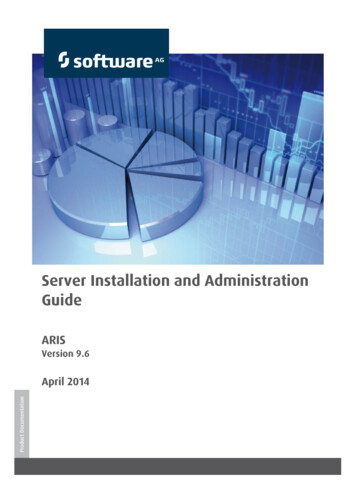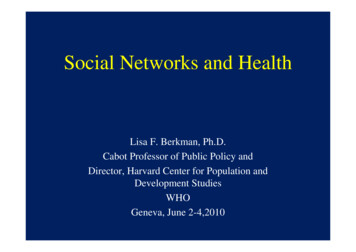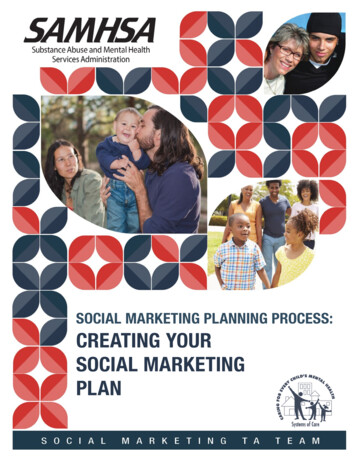
Transcription
Social and InformationNetworks
ResourcesMany of the things that we cover are from papers. Butsome references are the following books:Duncan Watts: Six Degrees: The Science of a Connected AgeA nontechnical introduction for the topics we covered and moreDavid Easley, Jon Kleinberg: Networks, Crowds, and Markets:Reasoning About a Highly Connected WorldAn introductory textbook with a lot of topics on networks (social and not)Also free at: ook/Malcolm Gladwell: The Tipping Point: How Little Things Can Make aBig DifferenceAbout success stories about how the tipping point works; an easy andinteresting readNicholas Christakis and James Fowler: Connected: The SurprisingPower of Our Social Networks and How They Shape Our LivesGeneral discussion about social networks, especially offline
What Is a Social Network? Social network: graph that represents relationshipsbetween independent agents.
Social Networks Are Everywhereand Are Important!Offline: Friendship network– “Show me your friend and I’ll show you who you are!” Professional contacts– Finding jobs Network of colleagues– Learning new techniques Network of animals– E.g., two cows are connected if they have been in the same area– Mad-cow disease
Nirvana
http://www.seattlebandmap.com
Seattle
Multiple Social Networks
Examples: Obesity:– People with obese friends have higher probability to becomeobese Smoking– If your friends smoke you have higher chances to smoke Happiness– If your friends make you happy you become happy There is effect not only to friends, but to friends of friendsand to friends of friends of friends
Social Networks Are Everywhereand Are Important!Online — Web 2.0 systems: Social networking systems Content sharing systems Content creation systems Online games
Online Revolution People switch more and more of their interactions fromoffline to online Pushing the # of contacts we can keep track of (Dunbarnumber) Redefining privacy Ideal for experiments in social sciences:– Ability to measure and record all activities– Massive data sets
Online Revolution
Online Revolution
Online Revolution
Online Revolution
Structure of Social Networks Social networks are an example of complex networks Other examples:– WWW, Citation graph, Biological networks, Internet, Telephonenetworks, Electricity grid, Studied by Mathematicians, Physicists, ComputerScientists, Sociologists, Biologists A lot of similar characteristics
Structure of Complex Networks1.2.3.4.One giant componentPower-law degree distributionsGlobally sparse, locally denseSmall world
Giant Component There is a large connected component containing thevast majority of the nodesThe second smallest is much much smallerThere are a lot of disconnected nodes
MSN Messenger
Power-Law Degree Distributions The degree distributions of the networks follow a powerlaw distribution What is power law?
Power-Law Distribution Exponential distribution: Power-law distribution:
Power-Law Distribution - 2 It is a heavy-tail distributionHeavy tail: It decays slower than an exponential It is also called scale-free: It appears in many places:–––––Degree distributionPopulation of citiesWord frequenciesWebsite hitsIncome
Power-Law Distribution - 3
Exponential Distribution
Back to Degree DistributionsInternet Graph
Web Graph Indegree
Web Graph Outdegree
Degree DistributionsIndegree of the *.brown.edu domain
Degree DistributionsOutdegree of the *.brown.edu domain
Flickr Graph, Indegrees &Outdegrees
Power Laws Everywhere
Power Laws Everywhere – 2
Power Laws Everywhere - 3
Globally Sparse, Locally Dense Social networks are sparse, i.e. small number of edges(think of facebook) They are locally dense: many of my friends are friendswith each otherCan we measure that?Expected number of triangles if links are random?Actual number of triangles?
Clustering CoefficientHow many of your friends are friends?Clustering Coefficient Cv of user v measures the densityof its neighborhood.vFor the entire graph:Cv 1 if all friends also linked to each-otherCv 0 if no friends linked to each-other
Small World
Small World
Small World
Small World
Small World
Small World – Facebook studyIn January 2012 researchers from Facebook and University ofMilan published results on the Facebook network Active users on May 2011 n 721M, m 69 B Average distance 4.74
Small World – Facebook study
Nicholas Christakis and James Fowler: Connected: The Surprising Power of Our Social Networks and How They Shape Our Lives General discussion about social networks, especially offline . What Is a Social Network? Social network: graph that represents relationships . – E.g., two cows are connec










